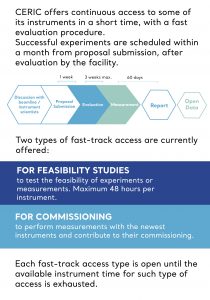Open Access
- Open Access
- Call for proposals
- User Guide
- Labs and Instruments
- Open Access Offer
- Battery Research
- Fuel Cells Research
- Login to VUO
- Review Panel
- How to Reach Us
- Accommodation
Open Access
Opportunities for Open Access
CERIC is open to researchers from all over the world, free of charge for non-proprietary research. In exchange for the free access, the users are required to publish the results of the experiments, with appropriate references to the CERIC facilities and to the local scientific and technical staff involved.
Read the CERIC Scientific Data Policy here
Semestral calls
Submission within the first deadline allows a pre-evaluation of the proposal at the facilities and, if necessary, two weeks for editing on the basis of the suggestions received, before final submission at the second deadline. Although we suggest taking advantage of the pre-evaluation, expert users may decide to submit their proposals directly at the second deadline.
Both single- and multi-instrument proposals should be submitted online through the Virtual Unified Office (VUO). The best projects will be selected by peer review through an independent and international panel of experts.
Access to CERIC is open to scientists from all over the world and free of charge. The only condition for free access is the publication of the results, with appropriate citation of the facilities and local contacts involved.
Proposals should be submitted online through the Virtual Unified Office (VUO). The best projects will be selected by peer review through an independent and international panel of experts. For further information about the evaluation and how to submit successful proposals, please use menu on the left side of this webpage.
In addition to the access to the facilities, as well as to the technical and scientific support from expert instruments’ scientist during proposal’s preparation, measurements and data analysis, partial support for user’s mobility is available through funding provided to CERIC from the Italian Ministry for Education, University and Research. Read the policy here. A maximum of two users for measurement may benefit from travel and accommodation support.
Fast-track Access

Proposals eligible for this fast access modality should have a strong motivation for applying through this channel, satisfying one or more of the following criteria:
- as for regular CERIC proposals, show a multi-technique approach of a scientific problem (although fast access can be requested for a single instrument)
- prove the need to test a new instrument or sample,
- be necessary to validate a result for an imminent publication, or
- any other valid justification for a fast and short access.
Proposals can be submitted any time, through the VUO.
Please note that discussion of your experimental plan with the instrument scientists is mandatory.
Instruments available
For the moment, it is possible to ask for fast-track access for feasibility studies to the following instruments:
Elettra Sincrotrone, Trieste
- SISSI-BOFF – Offline Synchrotron Infrared Source for Spectroscopy and Imaging
- IUVS-Offline – Inelastic Ultraviolet Scattering with fixed-energy sources (please note that the UVRR setup Trivista instrument of the facility can be requested for fast-track access for commissioning)
- Microfabrication Laboratory of TU Graz
Laboratory scattering facility, Graz
Nuclear magnetic resonance facility, Ljubljana
- David – 800 MHz NMR spectrometer
- Magic – 600 MHz NMR spectrometer
- Lara – 600 MHz NMR spectrometer
- Oro – 600 MHz NMR spectrometer
- Aska – 600 MHz NMR spectrometer
- Nika – 400 MHz NMR spectrometer
- Bond – 600 MHz NMR spectrometer
Surface physics laboratory at Charles University Prague
- EnviroESCA – Near Ambient Pressure Electron Spectroscopy
- LYRA – Focused Ion Beam Scanning Electron Microscopy (FIB-SEM)
- HTC – Hydrogen Technology Center
- FESEM – High Resolution Field Emmision Scanning Electron Microscope
Proposals can be submitted any time, through the VUO.
Please note that discussion of your experimental plan with the instrument scientists is mandatory.
Instruments available
For the moment, it is possible to ask for fast-track access for commissioning to the following instruments:
Elettra Sincrotrone, Trieste
- UVRR setup Trivista instrument of IUVS-Offline – Inelastic Ultraviolet Scattering with UV tunable laser sources



